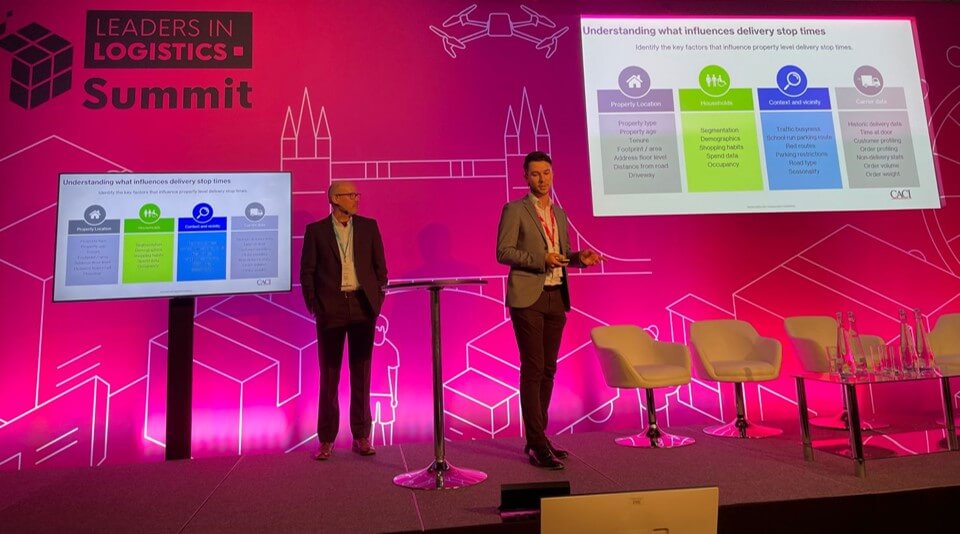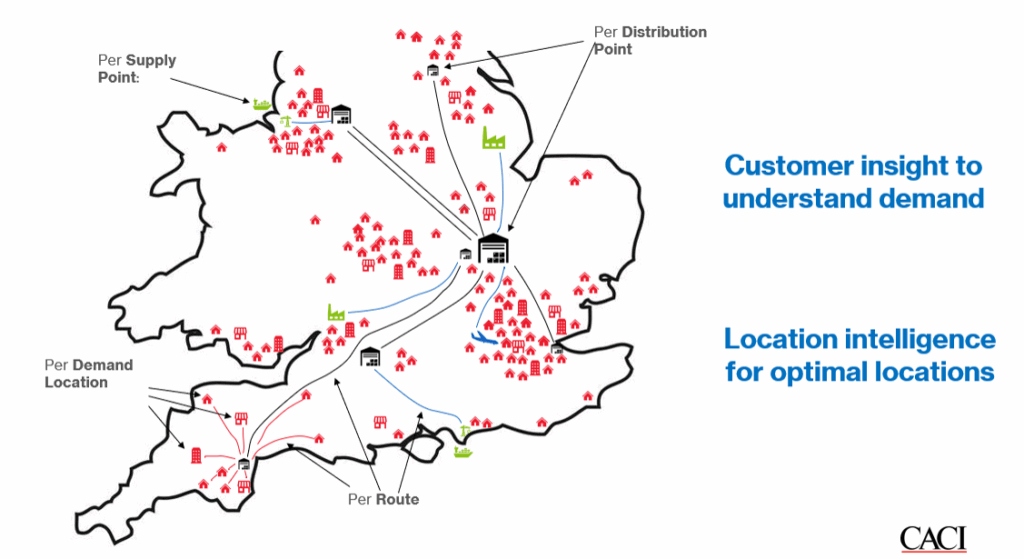How location intelligence & customer insight optimise fulfilment services

Nowadays, creating an optimal fulfilment service requires you to have access to sophisticated location intelligence data and superb knowledge of your customers. CACI’s Paul Dawsey and Dom Saunders, who work in the Logistics and Supply Chain business unit, presented the impact that location intelligence and customer insight have on optimising a distribution network and two examples of influential optimisation models at the Leaders in Logistics Summit on 28 March 2023.
Why are location intelligence & customer insight so important?
Having the right data for any type of location logistics solution is critical. Road network data, precise attributes and customer data are all critical parts of the distribution network optimisation process as they allow you to extrapolate the necessary details to ask the right questions and strategise accordingly.
There are several benefits that gaining these insights will have on your business’ operations, including:
- Improving your understanding of and ability to inform store locations, and expand or contract store locations accordingly
- Adhering to customers’ individual preferences for the delivery of products
- Personalising fulfilment options and determining what works best for specific customer demographics
- Enhancing the accuracy of your predictions for the length of time that drivers will need to spend at drop-off points, which will improve customer satisfaction and cut costs.
Example model 1: Network distribution modelling
To effectively model your distribution network, especially when making expensive decisions, your thought process should be backed by data. This will help you understand your customers in a way that will allow you to quantify and locate the demand that they have for your products, their consumption of your products, their collection preferences and more.
Once you have quantified and located demand, you can determine your baseline to strategically tweak the model you are building. Depending on what happens or changes in the marketplace and your sector in the coming years, and its impact on your model, you can formulate the right questions and conclude where changes need to be made.

Different customers will also present inevitably different logistics challenges. Profiling these customers will help you gauge how to better adhere to their existing and future demands. Pairing customer insight to understand demand with location intelligence to find the best locations to effectively reach your target customers will highly support the functionality of this model.
Finally, testing a range of ‘What if?’ scenarios depending on various changes your business may experience– population growth, market trends, what your market department is focusing on or how consumers will want to shop— will help you answer questions to gain strategic insights on your business’ efficiency, optimisation, costs, bottlenecks, products and services. This enables you to make recommendations for change.
When you take these answers and insights to the board for sign-off, you will have a significant amount of evidence through this model to back up your claims.
Example model 2: Delivery stop time modelling
Understanding the key factors that influence property level delivery stop times will ensure this model is created effectively. A grasp on the intricacies of property locations, households, context and vicinity and carrier data have become standard business practice for success in more recent years.
Effectively modelling property delivery stop times begins with accessing unique data feeds via customer and property intelligence data, road network and traffic data and carrier/historical customer data. These datasets can be then used in route optimisation tools such as CACI’s Pin Routes to fine-tune optimal routes, further increasing the level of optimisation. They show how dynamic the stop time analysis can be and how to consider running costs, regulations, and other impactful factors. They can also flag high traffic volume index, Acorn type, unloading duration and more to analyse existing stop times, compare delivery times, adapt strategies and conclude the optimal routes for drivers to take.
These data feeds support the development of your solution or model to produce an output of precise stop times based on customers’ addresses, enhance stop time generation and improve customer service and insights.
How can CACI help you optimise your fulfilment services?
Implementing a digital model that will showcase exactly what needs to change and improve will be paramount to running a successful, long-term distribution network. The right model based on the right data is what will help you build in the right way—gaining efficiencies, reducing costs and improving your customer service.
To find out how you can use location intelligence & customer insights to optimise your distribution network strategy, contact our team of experts.